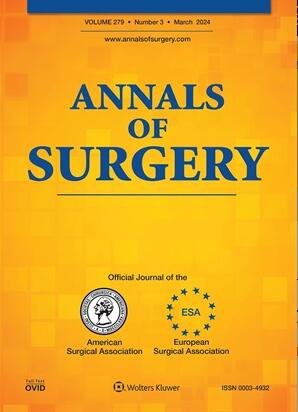食管癌新辅助治疗后食管癌切除术的新TRG-N预后分类系统:一项基于荷兰癌症登记的研究。
IF 6.4
1区 医学
Q1 SURGERY
引用次数: 0
摘要
目的建立以肿瘤消退分级(TRG)和ypN分期为中心的食管癌预后分级体系,对食管癌新辅助治疗(NAT)后R0食管切除术患者的总生存期(OS)进行有效分层。背景资料:虽然TRG和ypN分期结合的预后价值已被证实,但整合这些因素并使用大规模数据训练的预后分类系统仍然不可用。方法分析荷兰癌症登记处(2015-2022)的数据。基于cN分期、ypN分期和TRG对OS患者进行分组,建立了新的TRG- n预后分类系统。使用4个比较指标(Log-rank χ²、Linear trend χ²、Akaike’s Information Criterion [AIC]和C-index)比较TRG-N分类与第八版AJCC ypTNM分类的预后表现。结果共纳入3193例患者。腺癌患者中,TRG-N分类χ 2和AIC优于ypTNM分类。然而,TRG-N分类的Log-rank χ 2低于ypTNM分类,两种分类的c指数无显著差异(p值=0.206)。在鳞状细胞癌患者中,TRG-N分类在Log-rank χ 2、Linear trend χ 2、AIC、C-index等指标上均显著优于ypTNM分类(p值=0.018)。结论TRG-N分级与AJCC ypTNM分级对食管腺癌的预后表现相当,但对食管鳞状细胞癌的预后价值更高,使其成为食管癌患者风险分层的潜在有效工具。本文章由计算机程序翻译,如有差异,请以英文原文为准。
A Novel TRG-N Prognostic Classification System for Esophageal Cancer Undergoing Neoadjuvant Therapy Followed by Esophagectomy: A Study Based on the Netherlands Cancer Registry.
OBJECTIVE
To develop a new prognostic classification system centered on tumor regression grade (TRG) and ypN stage that can effectively stratify overall survival (OS) of esophageal cancer patients undergoing neoadjuvant therapy (NAT) followed by R0 esophagectomy.
SUMMARY BACKGROUND DATA
Although the prognostic value of combining TRG and ypN stage has been demonstrated, a prognostic classification system integrating these factors, trained using large-scale data, remains unavailable.
METHODS
Data from the Netherlands Cancer Registry (2015-2022) were analyzed. A new TRG-N prognostic classification system for OS was developed by grouping patients based on cN stage, ypN stage, and TRG. The prognostic performance of the TRG-N classification was compared with the 8th edition AJCC ypTNM classification using 4 comparative metrics (Log-rank χ², Linear trend χ², Akaike's Information Criterion [AIC], and C-index).
RESULTS
A total of 3,193 patients were included. Among patients with adenocarcinoma, the TRG-N classification showed superior Linear trend χ² and AIC to the ypTNM classification. However, the Log-rank χ² of the TRG-N classification was inferior to that of the ypTNM classification, with no significant difference in the C-index (P-value=0.206) between the two systems. Among patients with squamous cell carcinoma, the TRG-N classification significantly outperformed the ypTNM classification in Log-rank χ², Linear trend χ², AIC, and C-index (P-value=0.018).
CONCLUSION
The TRG-N classification demonstrated comparable prognostic performance to the AJCC ypTNM classification for esophageal adenocarcinoma but showed superior prognostic value for esophageal squamous cell carcinoma, making it a potentially more effective tool for risk stratification in esophageal cancer patients.
求助全文
通过发布文献求助,成功后即可免费获取论文全文。
去求助
来源期刊

Annals of surgery
医学-外科
CiteScore
14.40
自引率
4.40%
发文量
687
审稿时长
4 months
期刊介绍:
The Annals of Surgery is a renowned surgery journal, recognized globally for its extensive scholarly references. It serves as a valuable resource for the international medical community by disseminating knowledge regarding important developments in surgical science and practice. Surgeons regularly turn to the Annals of Surgery to stay updated on innovative practices and techniques. The journal also offers special editorial features such as "Advances in Surgical Technique," offering timely coverage of ongoing clinical issues. Additionally, the journal publishes monthly review articles that address the latest concerns in surgical practice.
 求助内容:
求助内容: 应助结果提醒方式:
应助结果提醒方式:


